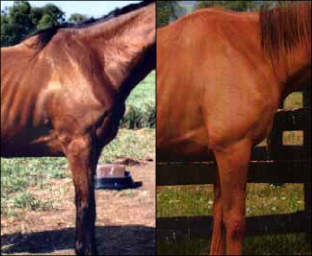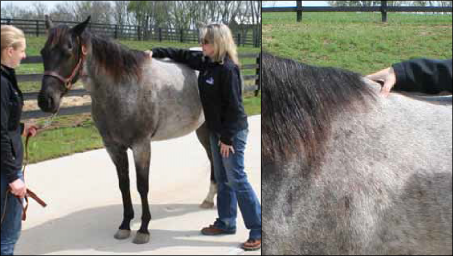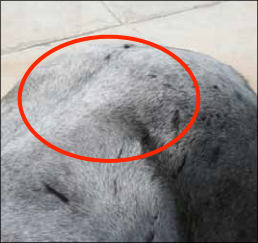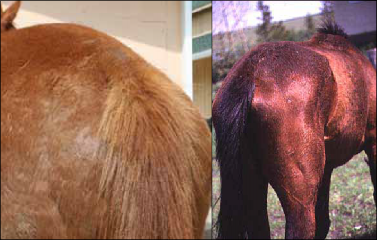Help! My Horse is Too Thin!
Help! My Horse is Too Thin!
Authors: Fernanda Camargo, Laurie Lawrence, and Bob Coleman, Department of Animal and Food Sciences
As we understand more about the impact that obesity and emaciation have on animal health, it is imperative that we strive to keep our horses at an optimum body condition. Since 1983, a procedure developed by Dr. Don Henneke has served to provide a standard body condition scoring system that can be used across breeds and by all horse people. The system assigns a numerical score—one through nine—based on the amount of fat that has accumulated in the important areas used to assess the body condition of horses.
Body Condition Scoring System
The Henneke system assesses accumulated fat both visually and by palpation in each of six areas: ribs, behind the shoulder, withers, loin, tailhead, and neck. A numerical value is assigned based on the fat accumulated in all six areas (Table 1).
Table 1. Henneke Body Condition Scoring System.
| Condition | Ribs | Neck | Withers | Loin | Tailhead | Shoulder |
| 1: Poor | Tailhead (pinbone) and hook bones project prominently |
Bone structure easily noticeable; animal extremely emaciated; no fatty tissue can be felt |
Bone structure easily noticeable |
Spinous processes project prominently |
Spinous processes project prominently | Bone structure easily noticeable |
| 2. Very Thin | Slight fat cover over ribs; ribs easily discernible |
Faintly discernible; animal emaciated |
Faintly discernible | Slight fat covering over base of spinous processes; transverse processes of lumbar vertebrae feel rounded; spinous processes are prominent. |
Tailhead prominent | Shoulder accentuated |
| 3. Thin | Slight fat cover over ribs; ribs easily discernible |
Neck accentuated | Withers accentuate | Fat buildup halfway on spinous processes but easily discernible; transverse processes cannot be felt |
Tailhead prominent but individual vertebrae cannot be visually identified; hook bones appear rounded but are easily discernible; pin bones not distinguishable |
Shoulder accentuated |
| 4. Moderately Thin | Faint outline discernible | Neck not obviously thin |
Withers not obviously thin |
Negative crease along back |
Prominence depends on conformation; fat can be felt; hook bones not discernible |
Shoulder not obviously thin |
| 5: Moderate | Ribs cannot be visually distinguished, but can be easily felt |
Neck blends smoothly into body |
Withers rounded over spinous processes |
Back level | Fat around tailhead beginning to feel spongy |
Shoulder blends smoothly into body |
| 6: Moderately Fleshy | Fat over ribs feels spongy |
Fat beginning to be deposited |
Fat beginning to be deposited |
May have slight positive crease down back |
Fat around tailhead feels soft |
Fat beginning to be deposited |
| 7: Fleshy | Individual ribs can be felt, but noticeable filling between ribs with fat |
Fat deposited along neck |
Fat deposited along withers |
May have positive crease down back |
Fat around tailhead is soft |
Fat deposited behind shoulder |
| 8: Fat | Difficult to feel ribs | Noticeable thickening of neck; fat deposited along inner buttocks |
Area along withers filled with fat |
Positive crease down back | Tailhead fat very soft | Area behind shoulder filled in flush with body |
| 9: Extremely Fat | Patchy fat appearing over ribs |
Bulging fat; fat along inner buttocks may rub together; flank filled in flush |
Bulging fat | Obvious positive crease down back |
Building fat around tailhead |
Bulging fat |
Adapted from Henneke et al. Equine Vet J. (1983) 15 (4), 371-372
 Ribs. The first place to look when assessing the body condition score (BCS) of a horse is in the ribcage. If ribs are easily seen, the horse will have a score over the ribcage below a 5. If you cannot see the ribs, then the score should be a 5 or above. During winter and spring it might be
Ribs. The first place to look when assessing the body condition score (BCS) of a horse is in the ribcage. If ribs are easily seen, the horse will have a score over the ribcage below a 5. If you cannot see the ribs, then the score should be a 5 or above. During winter and spring it might be
difficult to see ribs because of the horse's coat, so it is always important to run your fingers across the ribcage to assign the correct score. A very thin horse will have prominent ribs—easily seen and felt—with no fat padding. As the horse gains weight and body condition, a little padding can be felt around the ribs. By score 5, the ribs will no longer be visible, but can be easily felt. Once the body condition score is above 7, the ribs become more difficult to feel.
 Shoulder. A BCS of 5 means the shoulder blends smoothly with the body. At increasing condition scores, fat is deposited behind the shoulder and becomes bulging. This observation is especially true in the region behind the elbow. The shoulder bony structures will become more visible as the scores drop below 5.
Shoulder. A BCS of 5 means the shoulder blends smoothly with the body. At increasing condition scores, fat is deposited behind the shoulder and becomes bulging. This observation is especially true in the region behind the elbow. The shoulder bony structures will become more visible as the scores drop below 5.
 Withers. If a horse is very thin, no fat will be deposited between the top of the shoulder blade and the spinal vertebrae, making the two structures easily discernible. As the horse's condition score increases, fat fills in between the top of the shoulder blade and spinal vertebrae; so at a condition score of 5, the withers will appear rounded. As horses approach the high end of the condition scoring scale, the withers will be bulging with fat.
Withers. If a horse is very thin, no fat will be deposited between the top of the shoulder blade and the spinal vertebrae, making the two structures easily discernible. As the horse's condition score increases, fat fills in between the top of the shoulder blade and spinal vertebrae; so at a condition score of 5, the withers will appear rounded. As horses approach the high end of the condition scoring scale, the withers will be bulging with fat.
 Loin. The loin is the area of the back just behind where the saddle sits. At a condition score of 5, the loin area will be relatively level—the spine is not sticking up, nor is there a dent or crease along the spine. At condition scores below 5, the spine starts to become prominent; this is sometimes called a "negative crease." A very thin horse will have a definite ridge down the back where the vertebrae of the spine become obvious. As the condition score increases above a 5, fat begins to build up on either side of the spine and a visible crease starts to appear.
Loin. The loin is the area of the back just behind where the saddle sits. At a condition score of 5, the loin area will be relatively level—the spine is not sticking up, nor is there a dent or crease along the spine. At condition scores below 5, the spine starts to become prominent; this is sometimes called a "negative crease." A very thin horse will have a definite ridge down the back where the vertebrae of the spine become obvious. As the condition score increases above a 5, fat begins to build up on either side of the spine and a visible crease starts to appear.
 Tailhead. In a very thin horse, the tailhead is prominent and easily discernible. Once the horse starts gaining weight, fat fills in around the tailhead. As the condition score exceeds 7, the fat will feel soft and begin to bulge.
Tailhead. In a very thin horse, the tailhead is prominent and easily discernible. Once the horse starts gaining weight, fat fills in around the tailhead. As the condition score exceeds 7, the fat will feel soft and begin to bulge.
 Neck. In a very thin horse, you might be able to see the bone structure of the neck. As the horse gains condition, fat will be deposited on the top of the neck. At a condition score of 5, the neck blends smoothly into the body. Body condition scores of 8 and 9 are characterized by a neck that is thick all around with fat evident at the crest.
Neck. In a very thin horse, you might be able to see the bone structure of the neck. As the horse gains condition, fat will be deposited on the top of the neck. At a condition score of 5, the neck blends smoothly into the body. Body condition scores of 8 and 9 are characterized by a neck that is thick all around with fat evident at the crest.
Overall Score
After each area is assessed and assigned a score (not all horses will get the same score at each location) you can average all the scores to get to a final overall score. For example a horse might score 6 on some areas and 7 on others. For research purposes, the overall score can
have decimal numbers, but for practical purposes, most people would record a value of 6+ or 7-.
Putting the System to Work
Horses can perform almost every activity at a BCS of 5. Most athletic horses are kept at a BCS of 5, sometimes 6, depending on their discipline. Some equine athletes, such as endurance horses, will have condition scores between 4 and 5. However, keeping broodmares at condition scores below 5 may reduce their reproductive efficiency. In addition, horses with condition scores below 5 may lack the fat stores necessary to withstand a cold winter or other stressful situation. On the other hand, horses that have condition scores above 6 may be less exercise tolerant than their trimmer counterparts, and very fat horses may put extra stress on bones, joints and hooves. Horse owners should regularly condition score their horses to determine whether a change in body condition would be desirable.

Before starting any new nutritional program with a thin horse, it is important the horse be examined by a veterinarian first to make sure there are no underlying disease conditions. A good dental exam also is essential. Also, this fact sheet does not apply to horses that have a condition score below 3 or to horses that have been subjected to starvation. Starved horses
are not only thin on the outside; they may have organ and digestive tract deficiencies on the inside. Starved horses must be managed carefully and as above, must be examined by a veterinarian.
Making a Thin Horse Gain Condition
Follow these tips if you have a horse that needs to increase its body condition:
Think about calories first. A mature horse will gain weight and condition when the number of calories it consumes is greater than the number of calories it uses. Therefore, to increase body condition the horse must either increase calorie intake or decrease calorie use (or both). Calories are important to muscle gain as well as fat gain, so the diet's calorie value is important.
Understand where calories come from. Horses consume calories from their pasture, hay, and concentrate feed (such as a sweet feed). Most people underestimate the importance of hay and pasture in the horse's diet. If hay and pasture are good quality and abundant, they can contribute the majority of the calories that a horse needs. The fiber in hay and pasture is also important to keep the digestive tract healthy. If a horse receives too little fiber in its diet it may be less able to digest its other feeds efficiently.
Feed quality hay. Choose hay that was harvested at early maturity for horses that need to gain weight and body condition. Early maturity hay has more leaves, softer stems and very few seed heads. Early maturity hay is high in nutrients and it is palatable so horses will eat more of it. At this early stage of harvesting, legume (alfalfa, clover), grass (orchardgrass, timothy, bluegrass, etc.) or legume-grass mix hays are desirable for horses that need to gain weight. When you are comparing more mature hays, then mature legume hays will provide more calories than mature
grass hays. If mature hay is used then it will be more difficult to get a horse to gain weight. Mature hay is less digestible and less palatable (See ID-146, "Choosing Hay for Horses.")
Feed enough hay. Most horses will eat about 2 pounds of hay for each 100 pounds of body weight. So, a 1000-pound Arabian will eat about 20 pounds of hay a day; while a 1250-pound thoroughbred will eat about 25 pounds of hay a day. These are just average numbers and some
horses will eat more or less. Also, some waste is always expected so if the horse will eat 20 pounds per day, you will probably have to feed 22-24 pounds per day. If a horse has lost weight because it has been on restricted feed intake the amount of hay offered should be increased gradually. For example, if a horse has been in a poor pasture or in a group feeding situation
where other horses ate all the food first, its digestive tract will need time to adjust to a higher level of feeding. If you are offering hay and the horse is not eating it very well, make sure to have his teeth examined. If the dental exam is normal then consider trying a different kind of hay; the goal is to find something that the horse likes so it will eat more hay.
Make use of available pasture. Horses that have become thin during periods of training or even illness often benefit from turn-out into a high quality pasture. During the growing season a well-managed pasture can provide many nutrients and because grass is very palatable, it is good way to increase calorie intake. However, horses should always be adapted to pasture slowly to minimize the risk of digestive upset. Pasture can be an excellent source of calories, but only if there is enough nutritious and edible plant material in the paddock. Just because a pasture has green material in it doesn't
mean it has adequate nutrition. If horses kept on pasture are thin it suggests that the pasture is not providing adequate nutrition and supplementation is needed. The first feed that should be offered as a pasture supplement is hay. If hay is put in the pasture and the horses eat it readily it
probably means that the pasture quality is low.
Consider supplementing with a concentrate feed. After adjusting the hay and pasture offered to a thin horse, the concentrate portion of the diet should be evaluated. Concentrates (sweet feeds, pelleted feeds, or plain cereal grain like oats or corn) are used to provide a concentrated form of calories. One of the advantages of a concentrate is that it provides more calories than the same amount of hay. So if you gradually replace 5 pounds of hay with 5 pounds of a concentrate feed in the daily diet you can increase total calorie intake. There are many good quality commercially available Although you can use oats, corn or barley to provide calories. A commercially manufactured feed usually is more desirable because it is also fortified with other nutrients. Always purchase feeds that are formulated specifically for horses. Feeds formulated for other livestock may contain additives
that are toxic to horses.
How much concentrate? It is tempting to feed large amounts of concentrate to thin horses to get fast weight gain. However, large amounts of concentrate increase the risk of colic. So, it is generally safer to feed more high quality forage and less concentrate to achieve the same effect. If a horse has not been getting any concentrate, the first meals should be very small and then increased gradually. Large meals have a greater risk of digestive upset so if a horse is getting more than 5 pounds of concentrate per day, it should be divided into two meals. If it is getting more than 10 pounds of concentrate per day, it should be divided into three meals per day. Many feed companies sell concentrates with added fat. Fat is a good source of calories so fat supplemented feeds are useful for adding condition to a thin horse. Alternatively fat can be top-dressed on a regular concentrate. The most common way to do this is to add vegetable oil to each meal of concentrate. The amount of vegetable oil should be small at the beginning, to allow the horse to accept it; later the amount can be increased to 3-4 ounces per feeding.
Feeding management. Feeding the right feeds in the right amounts is important, but so is feeding management. Horses can become very aggressive during meal times, and invariably, lower horses in the pecking order will be chased out of their buckets and hay piles. In many cases the thin horse is the one at the bottom of the pecking order and the fat horses are the ones at the top of the pecking order. In group feeding situations, make sure feeders are spread out enough to allow all horses to eat at once. The best management practice is to feed thin horses separately to make sure that they get the amount of food they need. Horses can be fed in stalls, alternatively concentrate can be given individually using nose bags if horses are together in a paddock. If this is not possible, then consider re-grouping horses to put individuals with similar requirements together. For example, an older thin mare may do better if she is kept with weanling fillies than with younger fatter mares, because she will need the same quality of hay and amount of concentrate as the fillies.
Reduce calorie expenditure. A horse will gain weight if calorie intake is greater than calorie use. Therefore, decreasing calorie use, may also be necessary for a horse to gain weight. Horses burn calories in a number of ways, including during exercise, to stay warm in the winter,
running away from dominant horses, to fight flies in the summer, among many other ways. If you are having difficulty keeping your horse at an optimum BCS, you may want to decrease exercise levels until the horse has reached an adequate BCS. If the weather is cold, provide as much shelter as possible. Heat loss is increased by wind and wet so if the horse can remain dry and out of the wind, if will reduce the calories needed to stay warm. A blanket may also reduce heat loss, but make sure that the blanket is water proof, or your horse will be worse off carrying
around a wet, cold and heavy blanket. In hot weather a cool, well-ventilated area will also help minimize calorie use. Protection from biting insects will also reduce the horse's activity. Any other
management changes that will encourage a horse to spend more time eating and resting than moving about will help to reduce calorie use and increase calorie intake.
Change paddocks if the horse is lowest in the pecking order. Most horses will learn to live in peace with each other if they have enough space. However, some horses, especially the ones who were raised alone, will not have learned herd dynamics, and will put themselves
in jeopardy all the time. These horses don't understand horse body language, and therefore, will not get the cue and leave more dominant horses alone. The dominant horses will keep chasing these horses, who, in turn, will waste a lot of calories running around. Generally, dominant horses, will be fine if left alone, especially if there is enough space. However, there are cases where dominant horses bully younger horses or horses that are low in the pecking order. Regardless of what your case is, you will need to separate a horse that is constantly being
picked at by other horses. These horses live under constant stress and will never have a chance to put on weight. Moreover, it is not a safe situation for either you or your horse. There are countless cases where horses were run through fences, or handlers that were caught in the middle of a horse fight.
For More Information
If your horse is too fat and needs to
lose weight and condition, see "Help! My
Horse is Too Fat" (ASC-187).
